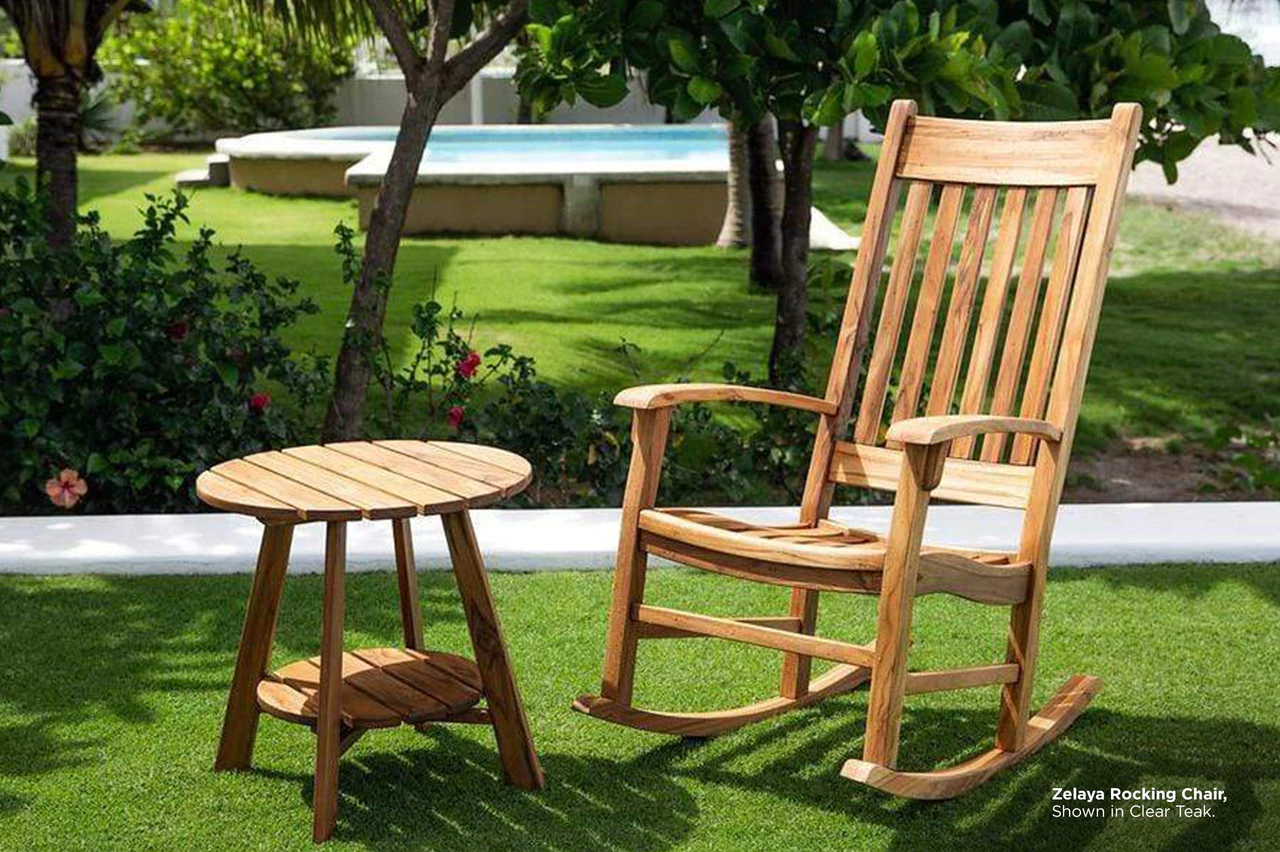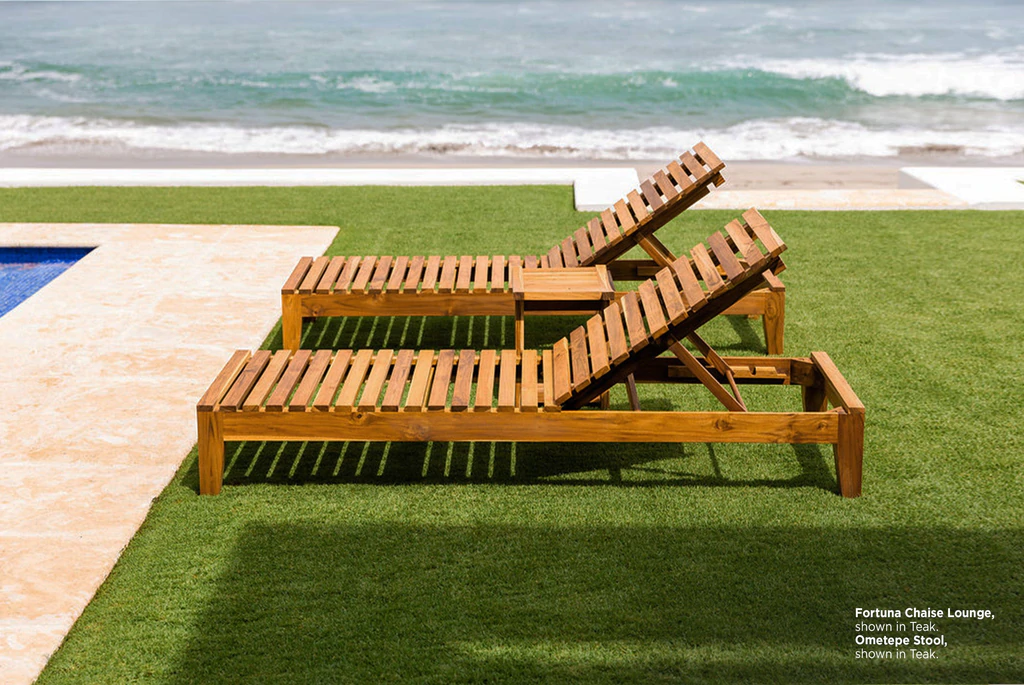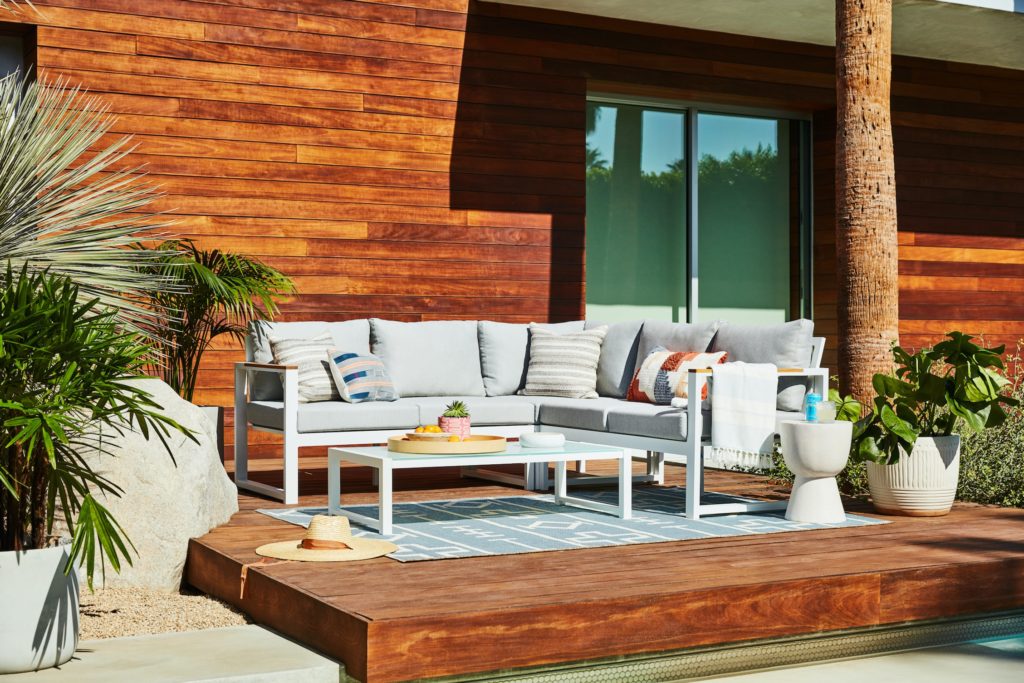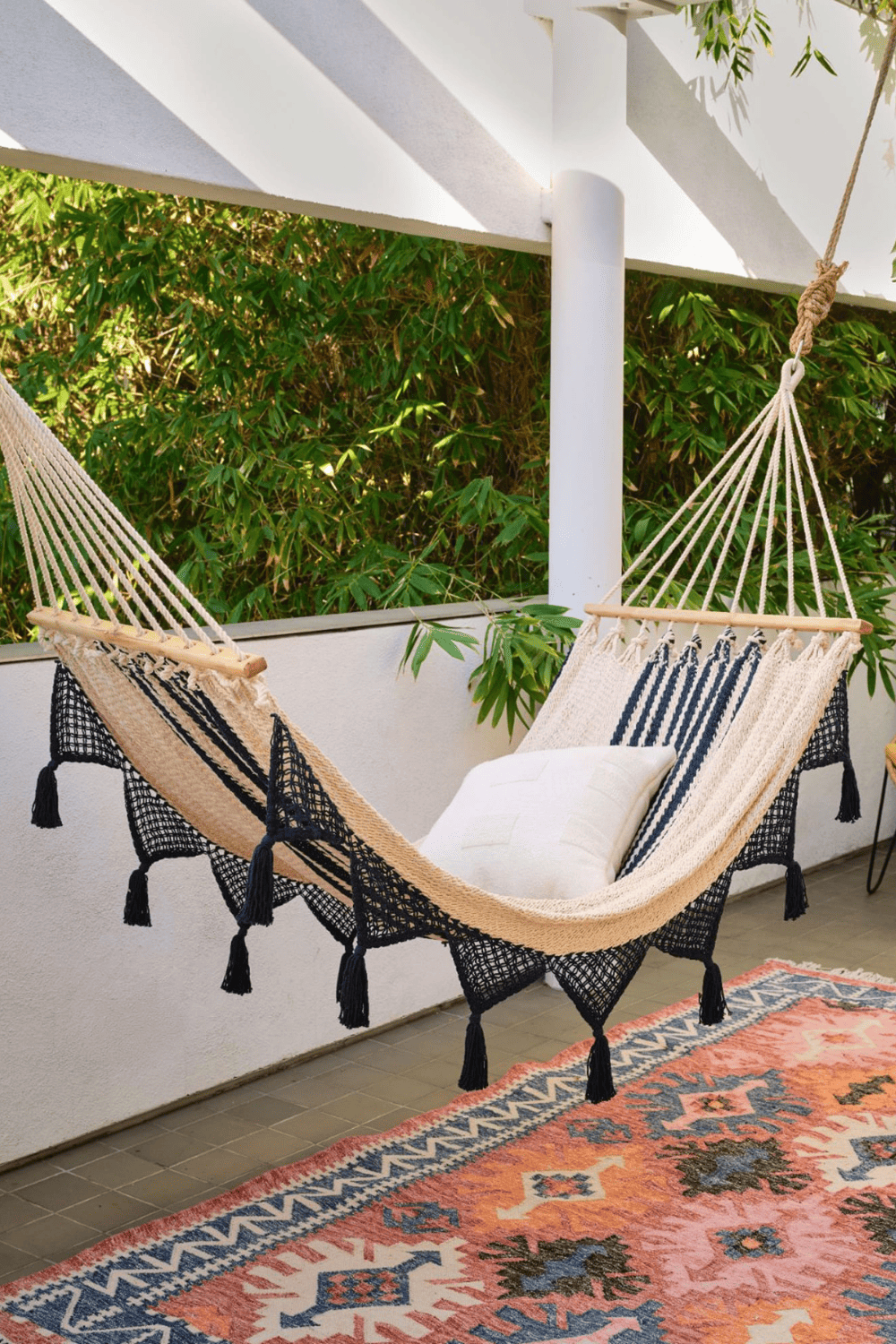Let me just get the bad news out of the way right off the bat: when it comes to non-toxic outdoor furniture, there isn’t really a perfect solution. There are very few outdoor furniture brands that meet all of the criteria in terms of performance, aesthetics, durability, and material safety.
But like most things in life, the goal is progress, not perfection. We’re shooting for the better, safer option, even if it’s not ideal.
So, I’m going to give you the resources you need to learn about what makes outdoor furniture toxic and what to consider when shopping for non-toxic patio furniture (or at least less toxic) so you can make a decision that’s best for you, your family, and your priorities.
P.S. I’ve also got you covered for indoor non-toxic furniture.
Non-Toxic Outdoor Furniture In a Nutshell:
- Toxic PFAS are very common in outdoor furniture. They’re added to fabrics to make them water/weather-resistant.
- These “forever chemicals” cannot be broken down in our bodies or in nature, so they linger forever, building up and causing serious health concerns.
- Choosing the best non-toxic and eco-friendly outdoor furniture will require choosing which areas are most important for you, your health, and your family’s health.
- I’ve found 5 PFAS-free and durable outdoor furniture brands that will meet your non-toxic and sustainable needs:
- Burrow (best overall)
- IKEA (cheapest)
- Masaya & Co. (most sustainable)
- The Futon Shop
- Joybird (but double-check before buying; not all of their products are PFAS-free)
Table of Contents
- Pick Your Poisons (Or Priorities!)
- Some Good News
- The Best Brands for Non-Toxic (Or Less Toxic) Outdoor Furniture
- Burrow Outdoor Furniture
- IKEA PFAS-Free Outdoor Patio Furniture
- Masaya & Co. Eco-Friendly Wood Outdoor Furniture
- Natural Home by The Futon Shop
- Joybird
- Sustainable Outdoor Furniture
- Or… Go For An Organic Hammock Instead!
- How to Properly Care for Your Outdoor Furniture
This guide contains affiliate links, which means we may earn a commission if you decide to make a purchase. As always, we only make recommendations that are genuine. Featured Image Credit: Burrow
Pick Your Poisons (Or Priorities!)
Considering the fact that you may not be able to find the perfect solution, you may have to prioritize and decide what’s most important to you.
Here are some of the main things to consider:
1. PFAS or No PFAS?
This is one of the biggest things to think about when it comes to outdoor furniture. PFAS—aka “forever chemicals”—are almost always added to outdoor furniture (especially ones that contain fabrics) in order to make them weather-resistant.
You’ve probably heard about PFAS before:
- They’re what makes Teflon non-stick pans toxic.
- They’re linked to a host of very concerning health effects, from cancer and heart disease, to birth defects, and more.
- They’re persistent and bioaccumulative, meaning our bodies can’t metabolize them or break them down. Instead, they just build up over a long period of time (which is how they got their nickname “forever chemicals”).
These “forever chemicals” act the same way in the environment — building up over time and contaminating the soil and drinking water. Sust as they bioaccumulate in humans, they do the same in marine and wildlife.
A lot of outdoor brands (even those touted as “sustainable” or “eco-friendly”) use “performance fabrics” like Sunbrella for their cushions, umbrellas, and other outdoor products because they are water-resistant and less prone to mold.
Although Sunbrella does have a few things going for it in terms of sustainability initiatives (such as OEKO-TEX and GREENGUARD certifications), it’s not always PFAS-free. Sunbrella does have some PFAS-free fabrics, but as of right now, it’s really difficult to determine whether or not the specific piece of Sunbrella furniture that you might get at Target or West Elm, for example, is made using the PFAS-free fabric or not. You can read my deep dive into Sunbrella right here.
As a rule of thumb, you should probably always assume that an outdoor furniture brand contains PFAS unless they say otherwise.
P.S. At the bottom of this article I discuss how to water-proof your furniture or other outdoor items without toxic chemicals!
2. Engineered vs. Solid Wood
A lot of furniture (both indoor and outdoor) is made using engineered wood, which can also be called plywood, MDF, particleboard, fiberboard, and other things.
The problem with engineered wood is that it’s made by gluing a bunch of pieces together (like wood chips, sawdust, etc.) to make it look like real wood. That process requires a lot of glues and adhesives, which are often high in formaldehyde and other volatile organic compounds (VOCs) that can evaporate into your air and contribute to air pollution.
Even though formaldehyde occurs naturally in wood (and even in our own bodies!), it can contribute to serious health effects at the high concentrations often found in furniture. That’s why I usually recommend choosing solid wood whenever you can.
Here’s where you’re going to have to start deciding what your priorities are.
When it comes to furniture that’s outside, if I have to choose between getting a PFAS-free outdoor sofa that’s made using engineered wood versus a couch that uses solid wood but has cushions that are treated with PFAS, I personally think I’d rather go with the former.
Even though the product might have higher levels of formaldehyde than I’d prefer, the fact that the couch will be outside where there is plenty of airflow and where the formaldehyde will not be contributing to my indoor air pollution makes me feel okay about it (choosing the lesser of the evils!).
IKEA is a great example for this scenario. They use a lot of engineered wood, which is not ideal. However, they have actually had a ban on PFAS since 2016, making all IKEA outdoor furniture PFAS-free!
3. Synthetic vs. Natural Materials
The next thing to consider is what materials are used for your fabrics and cushions. Most outdoor furniture is going to include at least some synthetic material.
So here are a few things to consider as you choose the best option for you:
- Bear in mind that cotton tends to be more vulnerable to mold compared to many synthetics.
- Hemp is naturally mold-resistant but extremely difficult to find in furniture cushions (unless you make your own…)
- But synthetic materials—which are mainly plastic materials that are derived from petroleum—are neither eco-friendly or non-toxic. But they are more resistant to mold growth.
- Synthetic fabrics also tend to be more affordable.
- A PFAS-free synthetic material is usually better for you than a set of outdoor cushions that are made with natural cotton but then treated with a PFAS finish.
- Olefin fabric is a pretty good option for outdoor furniture. Even though it’s synthetic (made with waste from oil production), it is a tightly-woven, water- and mold-resistant fabric that does not need to be treated with PFAS.
- When it comes to cushions, natural latex or kapok are ideal natural materials, but they’re very difficult to find. So you may end up settling for polyurethane foam.
Some Good News
Despite the fact that it’s difficult to find outdoor furniture that’s 100% sustainable and non-toxic, the good news is that we’re seeing a lot of good progress when it comes to phasing PFAS out of consumer goods.
When I first published this article in 2022, there were very few PFAS-free performance fabrics on the market. But over the past couple of years, the PFAS landscape has changed.
Some states, like California, have implemented bans on PFAS in consumer products such as clothing, which will go into effect over the next several years.
OEKO-TEX, the third-party certification has announced that it will be banning all intentionally-added PFAS in certified products.
This means that if companies like Sunbrella want to keep its OEKO-TEX certification, they’ll have to take the PFAS out of their fabric in the future.
I’ve also seen an increase in PFAS-free performance fabrics enter the market. I believe that over the next few years, we will see a lot more furniture brands using safer, PFAS-free fabrics that are still durable and water resistant.
The Best Brands for Non-Toxic (Or Less Toxic) Outdoor Furniture
Burrow Outdoor Furniture

Materials: Powder coated steel, wicker, Olefin fabric, PU foam
PFAS-Free? Yes
Price range: $450-6000+ (financing available)
Burrow is one of the few brands that’s making PFAS-free non-toxic furniture that also looks nice and is affordable. That’s why I was so excited to see they launched an outdoor furniture collection last year!
What I love:
- Their upholstered cushions use C0, which is a vegetable-based, PFAS-free durable water resistant solution.
- Their synthetic fabric is OEKO-TEX certified Olefin.
- The cushions are porous and engineered to avoid water retention, helping it dry faster and avoid mold growth.
- The outdoor sofas are modular so you can really get creative and switch things up year after year.
- They also offer non-upholstered outdoor furniture (see below)
What I don’t love:
- They do use synthetic materials but it’s a reasonable choice for outdoor furniture.
IKEA PFAS-Free Outdoor Patio Furniture


Materials: Solid & engineered wood, polyester, PU foam, nylon, and more
PFAS-Free? Yes
Price range: $9.99- 1,759
What I love:
- IKEA’s furniture is PFAS-free
- Affordable
- Lots of options
- You can sort to find the best options like filtering by solid wood
What I don’t love:
- Lots of synthetics (like PU foam in the cushions and engineered wood)
- Not super durable in the long-run.
- Don’t get stuck on IKEA for everything. For indoor non-toxic furniture there are a plethora of better options.
More about IKEA:
- How non-toxic is IKEA furniture
- What is Fast Furniture & What Can You Do About It?
Masaya & Co. Eco-Friendly Wood Outdoor Furniture


Materials: Solid wood, polyester
PFAS-Free? Kinda (I recommend choosing their wood-only pieces for a completely PFAS-free choice)
Price range: $158- 2,895
Masaya & Co. makes absolutely beautiful furniture (for both inside and outside)!
What I love:
- Each piece is handcrafted in Nicaragua
- Sustainably-sourced solid wood
- They grow their own teak on deforested cattle pastures as part of their reforestation project.
- Many pieces are PFAS-free (but not all)
- They have classic Adirondack pieces along in addition to other options.
What I don’t love:
- Some pieces use Sunbrella fabrics which, as I noted above, may be PFAS-free, but it’s not guaranteed.
- When filtering by PFAS-free pieces, sorting by wood-only pieces does limit your options.
- A little on the expensive side for outdoor furniture (but for a good cause, supporting a good company!)
Natural Home by The Futon Shop

Materials: Soy-based memory foam (with some synthetics), natural latex, solid wood, linseed oil finishes
PFAS-Free? Depends on the fabric
Price range: $296- 1,075.46
What I love:
- Their outdoor furniture has options for cushions made from natural materials (many of the other brands don’t).
- They offer a range of fabric types.
- They have an excellent customer service team who will not only answer your PFAS question but might guide you to products if you’re trying to avoid PFAS.
- Their collection of futon frames and chairs is multi-functional and can be used inside or outside.
- They use natural and non-toxic materials like solid wood and natural linseed oil for the finish.
- They offer a variety of options such as loveseats, futons, and chaise lounges that come in different sizes.
- The picture above is of the folding foam bed, which is available in a soy-foam and/or natural latex option. Depending on which type you choose, there may be some Certi-PUR certified synthetic memory foam as well.
What I don’t love:
- Not all options are PFAS-free so you’ll have to do some searching/digging.
- They use Outdura fabric (which is similar to Sunbrella). I’ve contacted them to ask if it contains PFAS and unfortunately have not received a response.
Joybird

Materials: FSC-certified wood, polyester, PU foam, aluminum, acrylic, and more
PFAS-Free? Kinda; the “majority” of their products are not treated
Price range: $291- 3,258
What I love:
- Most of their outdoor furniture is not treated with PFAS.
- They do not recommend applying Scotchgard to their furniture (neither do I—it usually means PFAS!).
- They have several beautiful options to choose from.
- Their pieces are often multi-functional.
What I don’t love:
- Like many of the other brands, they use a lot of synthetic material (such as PU foam)
Sustainable Outdoor Furniture
- Non-toxic and eco-friendly initiatives are often closely related. Most of the time, what’s better for our health is also better for the planet — but not always.
- When shopping for sustainable outdoor furniture, there are a few qualities you can look for:
- FSC certified, meaning the wood comes from responsibly managed forests.
- GREENGUARD Gold certification, which means products contain low chemical emissions and decreased indoor pollution.
- The use of reclaimed wood is a great eco furniture initiative.
- Recycled aluminum is another sustainable material in durable patio furniture.
- Before outlining the sustainability features of the brands mentioned in this blog, it’s important to note that the most sustainable kind of patio furniture you can get is something that’s already made. Check local groups, Ebay, Facebook Marketplace, and secondhand stores. But look for brands listed here that I’ve verified are limiting their toxins.
- Lastly, I completely understand the world is in a plastic crisis right now, with more plastic floating around than we know what to do with. Although reclaimed plastic may be better for the planet in some ways, it still contains the same toxins (sometimes more) as fresh, virgin plastic.
Now, here’s how the brands above stack up in terms of sustainability:
Massay & Co. Outdoor Furniture Sustainable Features:
Masaya & Co. is one of the best sustainable outdoor furniture brands. Their furniture is artisan hand-crafted and never mass produced. The inspiration for the brand comes from the rich culture and appreciation for Nicaragua. Some of their sustainable features include:
- They own their own tree farms established on deforested cow pastures
- A percentage of the forests they own are unused and untouched
- They plant trees in their own forest and donate to different initiatives
- All furniture is made from FSC certified wood
- In addition to their own forests, Masaya & Co. collects and germinates seedlings in their own nursery
- The waste that is created is converted into bioenergy
Joybird Outdoor Furniture Sustainable Features:
Joybird is known around the furniture industry for their fun, bright colors and comfy designs. Some of their sustainability initiatives include:
- They finance and invest in reforestation and restoration programs
- Some of their pieces contain reclaimed wood
- All furniture and fabrics are GREENGUARD Gold certified
- Fabrics are crafted from recycled water bottles
Burrow Outdoor Furniture Sustainable Features:
Burrow is all about high-quality furniture blending Scandinavian and mid-century designs. While their pieces are made from FSC certified wood and designed with a modular system that allows pieces to be repurposed over time, they’re unfortunately lacking in sustainability certifications (outside of PFAS-free which is a big one!).
Futon Shop Outdoor Furniture Sustainable Features:
The Futon Shop has made my list of recommendations in other categories for their commitment to non-toxic materials but they deserve a shout out for eco-friendly practices as well:
- They prioritize local farms and brands for material sourcing
- They use humanely harvested wool, which is beneficial for humans, animals, and the environment
- Their products use natural latex instead of synthetic
- Many of their materials are certified organic, including cotton
Outdoor Furniture Brands That Didn’t Make the Cut
Here are some of the other brands I looked at. All of these brands have sustainability initiatives of various kinds, however, none of these brands are clear about whether or not their outdoor furniture contains any PFAS.
I’ve reached out to all of these brands, but unfortunately never heard back. I’ll be sure to update this article if I ever do.
Therefore, I cannot recommend the following brands at this time because it’s likely their outdoor furniture DOES contain PFAS.
All of the brands with *asterisks* use Sunbrella fabrics, which means they could be PFAS-free since Sunbrella does have a PFAS-free line, but you just can’t know for sure since they don’t specify…
Terra*
Villa*
Yardbird*
Crate & Barrel*
Neighbor*
Pottery Barn*
West Elm*
Outer
Room&Board
Or… Go For An Organic Hammock Instead!
If it makes sense for you and your outdoor lounge area, you might want to go for natural and organic hammocks instead!
Home
4 Places to Get Natural, Organic, & Eco-Friendly Hammocks
Here’s what to look for in the best natural and organic cotton & hemp hammocks and our recommended brands.
How to Properly Care for Your Outdoor Furniture
No matter what decision you make, properly caring for your furniture can make a big difference, both in the long-term durability as well as preventing mold and mildew. So here are a couple of pointers:
Water & Stain-Proof Your Patio Furniture the Non-Toxic Way


There’s a reason most of the outdoor furniture on the market is treated with PFAS. Most people want their outdoor stuff to be weather resistant! However, you do have safer options.
Rawganique is a brand that is incredibly strict on material safety; all of its products are specifically made with the most chemically-sensitive people in mind. Rawganique carries two products made by Otter Wax that will help you waterproof your outdoor fabrics without toxic PFAS:
Both of these products are made in the USA out of natural ingredients like beeswax and plant-based waxes and oils. They’re both completely free from things like PFAS, petroleum derivatives, and other potentially problematic chemicals.
- The solid wax is a bit easier to use and requires fewer steps for application
- The liquid option is better for larger products (like furniture)
- Both of these options can be used on DIY cushions and other outdoor products like tents, hammocks, shoes, and more.
Force of Nature is another simple way to care for your outdoor furniture. This is a non-toxic spray that is registered with the EPA to kill 99.9% of germs, viruses, and bacteria, and it’s effective in preventing mold and mildew as well. It doesn’t have to be rinsed off, so you can spray it onto your upholstered furniture every other week or so as another preventative measure.
Proper Storage For Outdoor Furniture
In addition to treating your outdoor fabrics and cushions with natural weather-proof finishes, proper storage can go a long way, too!
To increase the life of your outdoor furniture and prevent mold without PFAS, store your cushions indoors when they’re not in use (even if that’s just in a shed or garage). At the very least, make sure to bring them in during periods of heavy rain and/or during the winter months.
Finding something that is all at once durable, PFAS-free, natural and/or organic, AND comfortable isn’t easy. But just as with everything: do what you can when you can! Hopefully this article has at least helped lay out your options and narrow things down so that you can make the best decision you possibly can!
If you found this guide helpful, be sure to sign up for our weekly newsletter to stay updated on the latest tips, news, and more!







Hi! We just ordered some bistro chairs from Serena & Lily (All-weather resin on powder coated aluminum frame). I know resin is far from non toxic but I wanted something that didn’t have a cushion and was easy to clean. I’m just now thinking that resin probably contains PFAS. Do you know anything about that?
Hi again Lindsey,
Yea, the powder coating is a really tough one because it’s really difficult to know whether there are PFAS or not… Did you by chance reach out to them and ask? I was going to email them but I couldn’t figure out from their website which specific product you purchased to ask them about it.
Hi! have you looked at JackFruit outdoor furniture… Looks nice & non-toxic…just super pricey. Reticent to buy without being able to try it out for comfort. But that is true of many of these companies..
Unfortunately, I haven’t been able to get a straight answer from Jackfruit… I emailed them to ask about PFAS and they told me that the water-resistant properties come from the fabric itself, which is polyester. However, in their FAQS, it says that their fabrics feature a “nontoxic moisture barrier,” which is contradictory to what they’re telling me via email. If I ever get a more clear answer from them, I may consider adding them in the future.
Purchased some sofa cushion covers online & fabric List is in Chinese. Covers are
designed to protect furniture from pets so assuming there are PFAS in fabric. Also assuming safety standards are lower in China. How can I verify?
Hi Rose,
What brand did you order from? I would contact the brand to ask for more information. And the safety standards are not necessarily lower in China; it depends on the factory.
What about Polywood outdoor furniture and cushions? Do they contain PFAs?
Probably. They don’t say anything about being PFAS-free and they say their fabric is weather-resistant, which usually indicates PFAS. https://www.polywood.com/our-materials/fabric
Do you know if powder coated steel furniture (like steel benches or chairs) tend to be treated with PFAS?
Unfortunately, it can be. And it can be difficult to know whether a specific piece is or not. 🙁
Hello! Do you have suggestions for less toxic outdoor furniture covers? Thank you
Hi Luna, I would check out Burrow’s covers! (https://fave.co/43IW23T) They’re made from polyester, but for something like this, you’re probably better going with a synthetic fabric. Burrow uses C0 to make their fabrics water-resistant, which a veggie-based PFAS-free treatment.
Do you know of any other brands for non-toxic covers? I’m looking for a table cover and Burrow does not carry that. Thanks!
Hey Lindsey,
See if this one from IKEA will work for you: https://www.ikea.com/us/en/p/tosteroe-cover-for-outdoor-furniture-table-and-chairs-black-70532340/
It says it’s made from rubber and polyester. A lot of the other ones I looked at use PVC, which is the main material you’d want to try and avoid if possible.
Hi great article and info! Any suggestions for an outdoor rug that’s LESS toxic? Thanks!
Ashley
Great question!
It looks like Revival Rugs are made from recycled plastic and APPEAR to be untreated. (https://www.revivalrugs.com/collections/outdoor-rugs)
West Elm doesn’t say anything about treatment, but I would definitely ask them first. (https://www.westelm.com/search/results.html?words=outdoor%20rug)
The other option would be to get a rug that’s not explicitly made for “outdoors” but is made out of something like jute that works well for outside. Some brands to check out are:
https://lorenacanals.com/us/
https://hookandloom.com/
https://organicweaveshop.com/
https://rawganique.com/search?type=product&q=rugs
https://willabyshop.com/collections/rugs
We will do some more research on this and add another section to this article!